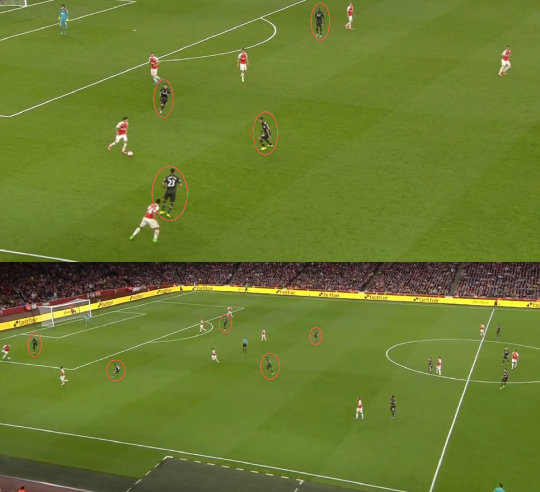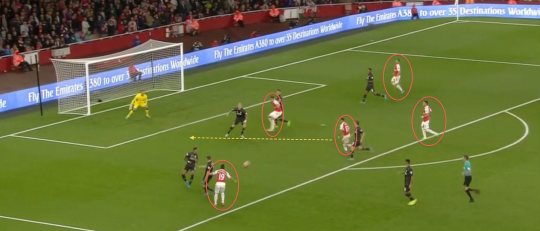Over the last few years, the match ups between Arsenal and Liverpool have been some of the best of their respective seasons. The 4-4 in the 2008/2009 campaign, the 5-1 Liverpool win in 2013/2014, and last year’s 4-1 Arsenal win. With that in mind, the expectation was that there would be goals in this game and certainly could have been had it not been for Petr Cech and Simon Mignolet.
Arsene Wenger named the same starting XI that beat Crystal Palace with the exception of both centre backs in Mertesacker and Koscielny, out through illness and injury, respectively. In their place, Calum Chambers and Gabriel were given starts at the heart of Arsenal’s defence in a 4-2-3-1.
Brendan Rodgers made changes to his side as well, with Jordon Ibe dropping to the bench and Jordan Henderson and Adam Lallana out through injury. In their place, Roberto Firmino was given his first Liverpool start, while Emre Can and Lucas were part of the midfield three in Liverpool’s 4-3-3.
Liverpool Press, Control Space
During preseason, Brendan Rodgers hinted that Liverpool would go into some games with the mindset of sitting back and controlling space (you can find the quote here in this Liverpool season preview) and this is exactly what the plan was against Arsenal. Early on it became clear that Liverpool were going to allow Arsenal to have the ball, although this does not mean that they were not going to press Arsenal. A team can control space in any part of the field, so pressing falls under having the ability to control space. Pressing is usually associated with teams that like to have the ball (there are of course exceptions like Atletico Madrid). While ‘controlling space’ is usually associated with the idea of sitting back in a mid or low block (another aspect of Simeone’s Atletico Madrid, while we are using that example). With that said, Rodgers had his side pressing Arsenal very well in the first half of the match and because of it, Liverpool got a number of chances.

While a number of the times that Liverpool won the ball back were because Arsenal’s poor passing throughout the first half, it has to be said that Liverpool and Rodgers picked the right times to press the Gunners. Liverpool never pressed, at least effectively, with less than four players, with Emre Can or James Milner’s presence in the final third something of a trigger. Usually, pressing triggers come from the what the team with the ball is doing and Liverpool seemed to have these as well; when Bellerin had the ball, Liverpool targeted him, same with when Chambers had the ball. So while it did depend on where Arsenal’s possession was, Liverpool only pressed when already had numbers high up the pitch. Two screen captures below show just that, with the second still, in particular, showing an excellent display of pressing.

These moments came, however, were limited to short periods in the first half. For much of the match, especially in the second half, Liverpool sat back and ensured that everything Arsenal did was in front of everyone except Benteke, who was used as a long ball outlet. In the first half, Liverpool defended in a 4-1-4-1 in a midblock and Arsenal struggled to grow into the match for a number of reasons. One of biggest being that Liverpool limited the space between the lines. Lucas patrolled this area of the pitch, but the four in front of Lucas were very narrow, limiting the passing lanes into central areas and forcing play out wide, while Liverpool’s back four played relatively high, squeezing the space behind Lucas. It worked for Liverpool as, aside from Sanchez, Arsenal were without a player that could threaten the away side by running in behind. Below is an excellent example of Liverpool’s midblock in the first half.

Ramsey, Özil, Sanchez Fluid
Arsenal needed to make changes at half time. If it were not for Cech, Liverpool could have been 2-1 up at half time, but the new Arsenal keeper made two excellent saves, jumping across the goal to keep out a Benteke tap in and tipping a Coutinho effort against the post and Arsenal had a goal wrongly ruled offside. Defensively, things did not really change, rather, it was the three players behind Giroud that made the difference. In the first half, Ramsey, Sanchez, and Özil were very static, sticking to their starting positions and it allowed Liverpool to easily dictate where Arsenal went with the ball (controlling the space). In the second half, however, the Arsenal trio became much more fluid when Arsenal got on the ball.
Ramsey enjoyed drifting inside alongside Cazorla and Coquelin and it is in these central areas that Ramsey becomes more of a threat. Yes, he added numbers to Arsenal’s midfield, but Liverpool’s midfield was already narrow. What he added instead was energy from deeper positions. During the 2013/2014 season when Ramsey was played centrally, he netted ten league goals, seven more than his previous high. So many of those ten goals were down to Ramsey’s energetic runs starting from alongside Arteta and being played in by the likes of Özil, who looks for those runs in behind. In relation to this match, when Ramsey moved inside, it gave Arsenal a player that enjoys playing centrally and knows how and when to make forward runs from a central area (the goal he scored in the first half was a perfect example), which gave Özil a target to play in, and the runs helped pushed Liverpool back giving Arsenal’s creative players more space to get on the ball. The Welshman also linked up well with Özil and Sanchez as he drifted to the left side of the pitch.

Özil and Sanchez began finding more space as Liverpool were pushed back and the visiting side looked more like a 4-2-3-1 with Milner dropping alongside Lucas and Can just in front of the two. The two Arsenal players enjoyed combining with one another and much of Arsenal’s play in the second half, which was majority of the play, came down Arsenal’s left through Sanchez, Özil, and Cazorla. All three are clever players and Arsenal had their best moments when they were involved in the intricate play around the Liverpool penalty area. Below is a screen capture of just before Sanchez’s shot that when off the outside of post.

Wenger brought on Walcott for Giroud in the 73rd minute, but at this point, Liverpool were defending deep so Walcott’s pace was void and he was not involved in Arsenal’s forward play much, completing just one pass. Oxlade-Chamberlain was brought on in the 82nd minute for Coquelin and it was perhaps too late as Coquelin’s role in the second half was rather limited. He isn’t a great passer of the ball and his ball winning was not particularly needed with Liverpool rarely on the ball and rarely looking to play forward on the ground. Oxlade-Chamberlain’s impact was positive and gave Arsenal width on the right side of their attack, stretching Liverpool’s back four a bit more and opening up some spaces centrally.
Liverpool Adapt
As mentioned above, Liverpool looked more like a 4-2-3-1 in the second half as they sat back and the more comfortable and adapted they looked, the more it seemed like they were back in control defensively. As the second half went on, Liverpool sat deeper and deeper and it was clear that the plan was to sit and counter, especially when Ibe and Moreno were brought on for Firmino and Coutinho. As Arsenal got more and more of the ball and played down the left with just about every attack, only switching it occasionally, Liverpool just crowded out any space in behind or around Arsenal’s sparks; the Gunners had to continually recycle the ball. Below is a good example of Arsenal overloading the left side of the pitch, while Liverpool close out the spaces to play in.

Going forward, Liverpool had to adapt as well. They saw a decent amount of the ball in the first half, but in the second half were starved of it, meaning that Benteke’s ability to hold up the ball was even more important. Throughout the match, Liverpool had been playing the ball long to Benteke with Coutinho and Firmino fighting for knockdowns and looking to play one another in, while Clyne was almost always an outlet on the right side of the attack, but in the second half Benteke was isolated and so rather than knockdowns the Belgian had to hold the ball up and bring others into play, which he did well. Liverpool were able to get numbers forward at times, but much of their play going forward was a ball up to Benteke and then the likes of Can bursting from midfield to support the big man. Can did really well in this aspect of the match, he was almost always the first to support Benteke in the second half, shuttling from box to box with constant energy.

Conclusion
A match that either side could have won. Liverpool should have scored, hitting the woodwork twice, one because of Cech, while the keeper saved another excellent chance that came to Benteke in the first half. Arsenal had a goal called back for a wrongly called offside while Sanchez hit the post. In the end, despite the chances and history of scoring in these fixtures, we end with an entertaining and tactically interesting 0-0.
Liverpool were by far the better side in the first half and, while Arsenal did make changes in the second half, Rodgers seemed to stick to his idea of pressing for certain parts of matches and then sitting back for others. In this match, Liverpool were much better when they forced Arsenal to make quick decisions on the ball rather than sitting back and allowing the home side to have the ball. As much as Rodgers might seem to think it is in Liverpool’s best interest to look to control space in some matches, it is reminiscent of some of last year’s performances where Liverpool allowed teams to bully them with the ball. Regardless, Liverpool remain unbeaten in their first three matches, gathering seven points.
Arsene Wenger admitted that Arsenal have started the season poorly. They certainly struggled in the first half of this match, but the changes at half time allowed them to grow into the game and dominate the ball and chances in the second half. Arsenal may feel as they got away with one, knowing that there are not too many matches against the ‘big’ clubs in the league where a Chambers and Gabriel pairing would be able to keep a clean sheet.
Peter Motzenbecker
Latest posts by Peter Motzenbecker (see all)
- Liverpool vs Manchester City: Tactical Analysis - January 17, 2018
- The Manchester Derby: Post-Match Tactical Analysis - September 13, 2016
- Arsenal vs Liverpool: The Tactical View - August 17, 2016

